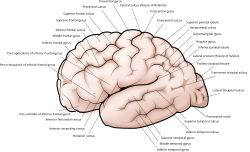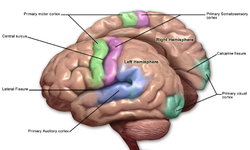Cerebral cortex
Structure: – The cerebral cortex is the outer covering of the cerebral hemispheres. – It is folded into peaks called gyri and grooves called sulci. […]
Structure:
– The cerebral cortex is the outer covering of the cerebral hemispheres.
– It is folded into peaks called gyri and grooves called sulci.
– The cortex is 2-4 mm thick and makes up 40% of the brain’s mass.
– 90% of the cortex is the six-layered neocortex.
– Between 14-16 billion neurons are organized radially in cortical columns and layers.
Folds:
– The folding of the cortex allows for a large surface area of neural tissue.
– Unfolded, each hemisphere has a surface area of about 0.12 square meters.
– Most mammals have convoluted cortices with gyri and sulci.
– Small mammals like rodents have smooth cerebral surfaces.
– The folding is inward and present on the medial surface of each hemisphere.
Lobes:
– Major sulci and gyri mark the divisions of the cortex into lobes.
– The four main lobes are frontal, parietal, temporal, and occipital.
– The insular cortex is often considered the insular lobe.
– The limbic lobe is on the medial side of each hemisphere.
– Three lobules are described: paracentral, superior parietal, and inferior parietal.
Thickness:
– Larger-brained mammals tend to have thicker cortices.
– The cortex is thicker over the top of a gyrus and thinnest at the bottom of a sulcus.
– The neocortex comprises about 90% of the cortex.
– The cortex is organized into different regions known as cortices.
– Two-thirds of the cortical surface is buried in sulci.
Function:
– The cerebral cortex plays a key role in attention, perception, awareness, and memory.
– It is responsible for cognition, thought, language, and consciousness.
– Specific functions are located in different cortical areas.
– The motor cortex primarily controls movement.
– The visual cortex is located in the occipital lobe.
The cerebral cortex, also known as the cerebral mantle, is the outer layer of neural tissue of the cerebrum of the brain in humans and other mammals. It is the largest site of neural integration in the central nervous system. and plays a key role in attention, perception, awareness, thought, memory, language, and consciousness. The cerebral cortex is the part of the brain responsible for cognition.
| Cerebral cortex | |
|---|---|
 | |
 Motor and sensory areas of the cerebral cortex | |
| Details | |
| Part of | Cerebrum |
| Identifiers | |
| Latin | cortex cerebri |
| MeSH | D002540 |
| NeuroNames | 39 |
| NeuroLex ID | birnlex_1494 |
| TA98 | A14.1.09.003 A14.1.09.301 |
| TA2 | 5527, 5528 |
| FMA | 61830 |
| Anatomical terms of neuroanatomy | |
The six-layered neocortex makes up approximately 90% of the cortex, with the allocortex making up the remainder. The cortex is divided into left and right parts by the longitudinal fissure, which separates the two cerebral hemispheres that are joined beneath the cortex by the corpus callosum. In most mammals, apart from small mammals that have small brains, the cerebral cortex is folded, providing a greater surface area in the confined volume of the cranium. Apart from minimising brain and cranial volume, cortical folding is crucial for the brain circuitry and its functional organisation. In mammals with small brains, there is no folding and the cortex is smooth.
A fold or ridge in the cortex is termed a gyrus (plural gyri) and a groove is termed a sulcus (plural sulci). These surface convolutions appear during fetal development and continue to mature after birth through the process of gyrification. In the human brain, the majority of the cerebral cortex is not visible from the outside, but buried in the sulci. The major sulci and gyri mark the divisions of the cerebrum into the lobes of the brain. The four major lobes are the frontal, parietal, occipital and temporal lobes. Other lobes are the limbic lobe, and the insular cortex often referred to as the insular lobe.
There are between 14 and 16 billion neurons in the human cerebral cortex. These are organised into horizontal cortical layers, and radially into cortical columns and minicolumns. Cortical areas have specific functions such as movement in the motor cortex, and sight in the visual cortex. The motor cortex is primarily located in the precentral gyrus, and the visual cortex is located in the occipital lobe.